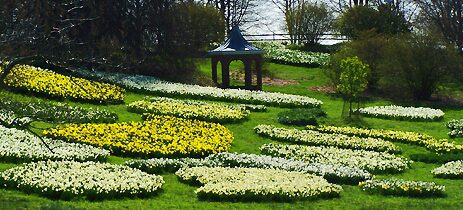
Winterthur’s daffodil display is one of the Brandywine Valley’s best kept secrets. Planted in drifts by the thousands, daffodils are a visual high note in the garden, flowering in between the peak displays of minor bulbs on the March Bank and azaleas and rhododendrons in Azalea Woods.
Planted along the main drive, Clenny Run, and Sycamore Hill, Winterthur’s sweeps of daffodils have remained much the same as when H. F. du Pont planted them. Narcissus had always been a favorite of Mr. du Pont’s, with some of the earliest plantings taking place in the March Bank by 1902. He developed a system of planting that revealed his plantsmanship and knowledge of design. He wrote in the
Daffodil and Tulip Yearbook 1961, “Always plant the varieties separately. This is one of the essential and all-important lessons the intending planter must learn, as there can be no comparison as to the more pleasing effect of a bold expanse of one variety than that of a mixture.” Du Pont believed in informal beds, and used the curved and irregular shapes of tree branches to create the outlines for his daffodil sweeps.
The results of du Pont’s efforts are still enjoyed today and are a highlight of the spring landscape. A large part of the display can be enjoyed on your drive into Winterthur. The long drift of
Narcissus ‘Queen of the North’ along Clenny Run, is just coming into full flower and can be seen to the right as you reach the bottom of the drive. The rest of the display can be seen near Sycamore Hill as you ride the garden tram or stroll through the garden.
Please visit our
updated prediction on the progress of flowering in Azalea Woods.
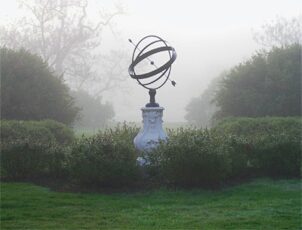
A week of sunny weather in April can give a gardener amnesia. Suddenly you find yourself planting as though it is May, forgetting that the nights can still get cold and turn your hard work into mush. Because today has been cool and cloudy I’ve already had two calls from gardeners asking for advice on frost. Keep in mind that it is not typically cool cloudy days that bring frost; frost is much more common on clear, cool nights with little wind.
Frost damages tender plants by causing cell walls to rupture. You can simulate the effect by putting a leaf of iceburg lettuce in a freezer for a minute. As the lettuce demonstrates, the leaves of a frost damaged plant wilt as though they have been crushed and will not recover on thawing. To keep frost at bay you can use any number of simple strategies. Begin by watering your plants thoroughly during the day, as water and soil are effective thermal masses that will help keep the micro-climate around your plants warmer. If your plants are in pots or trays, move them into a garage or shed for the evening. Alternatively, cover plants with sheets/blankets, paper/newspaper, or sheets of plastic. You can use stakes distributed throughout your beds to hold the covers off of the foliage of your plants. Remember to remove covers as the sun comes out the next day to prevent overheating. If your plants are damaged, but not killed, you can clip out the frost-damage and they should be fine.
A question we often hear this time of year is, “When should I prune my spring flowering shrubs?” Azaleas and forsythia, for example, can take us by surprise in spring by how much they have grown. You may need to prune your shrubs to restore their shape or to reclaim a path or part of a bed. In general, the correct time to prune these shrubs is right after flowering. Prune by removing weak or damaged wood and by cutting flowering branches back to areas of vigorous growth. Be sure to keep an eye on the shape and habit of the plant by stepping back and reviewing your work frequently. By pruning right after flowering, you allow the plants to develop replacement shoots that will mature and flower the next season. If you delay pruning too late into the growing season, or into the winter, new shoots won’t develop or they will not ripen enough to produce flowers. This rule of thumb can be used as a general guide for azaleas, forsythia, corylopsis, flowering quince, lilacs, and most other shrubs that flower in spring.

On the second Saturday of each month, one of our staff members leads a walk highlighting something special in the garden or on the estate. These
‘Second Saturdays Walks’ are free to
Members and are included in the Garden & Galleries pass for nonmembers. The walks have become a great way for us to meet and share the landscape with our supporters. This Saturday’s walk will highlight
winter hazels and azaleas, but will also include many of the other spectacular sights in the garden.
In case of inclement weather, call 302.888.4915 after 10:00 am. Walks last approximately 90 minutes and begin at the Visitor Center.
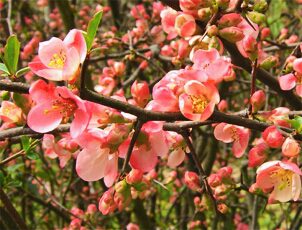
The blossoms of flowering quince are a sure sign that Winterthur’s Sundial Garden is about to come into its own. In the Sundial Garden, April is like a fireworks show—light the fuse and stand back. This part of the Winterthur Garden was not designed to offer multiple seasons of interest; instead, it was created to look its best in April. With the warmth of the last couple of days, magnolia, quince, and spiraea have begun their display. Presiding over this colorful performance is one of Winterthur’s finest specimen trees, a large, cloud-like Magnolia called ‘Wada’s Memory.’
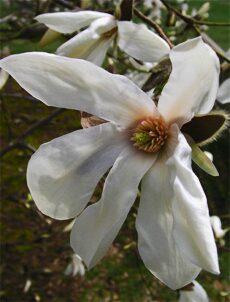
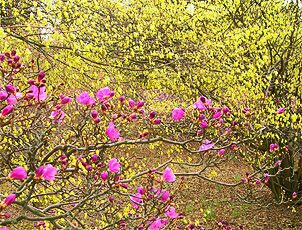
One of the most spectacular plant combinations in the Winterthur Garden is near its peak; the Winter Hazel Walk is a collage in shades of purple and pale yellow. The Walk combines the butter yellow of winter hazel (
Corylopsis spp.) with the pink to purple flowers of the Korean azalea (
Rhododendron mucronulatum). Hellebores, evergreens, and shrubs like the cherry prinsepia (
Prinsepia sinensis), play supporting roles. A visit in the morning or evening is a perfect time to enjoy the azaleas backlit against thousands of winter hazel blossoms.
More information about the garden and a
bloom calendar.
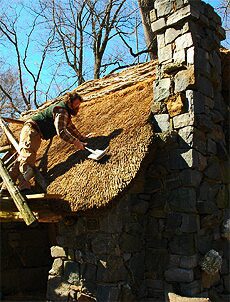
I am pleased to announce that the Faerie Cottage in
Enchanted Woods has been re-thatched. Our thatcher, William Cahill, spent several weeks replacing the mossy and worn roof on the cottage with fresh thatch. In the spirit of recycling and conservation, our new thatch roof uses phragmites, a common wetland grass found throughout the area that is considered by many to be a nuisance. Our phragmites roof should last much longer than a traditional reed thatch and uses a local weed that many consider fit only for the landfill.

Spring has arrived in the Winterthur Garden. The birds are singing, the flowers are blooming, and the white arrows have come out of hibernation to direct guests through the garden for Spring Tour. The route starts at the Visitor Center, meanders through the garden highlighting weekly seasonal changes, and ends at the Dorrance Gallery by the Reflecting Pool. Come out to see some old favorite floral combinations and perhaps a few hidden treasures!
Welcome to Winterthur’s Garden Blog. This is the first of what we hope will be many posts, with news and information about the garden and grounds of
Winterthur Museum & Country Estate in Winterthur, Delaware.
 Winterthur’s daffodil display is one of the Brandywine Valley’s best kept secrets. Planted in drifts by the thousands, daffodils are a visual high note in the garden, flowering in between the peak displays of minor bulbs on the March Bank and azaleas and rhododendrons in Azalea Woods.
Planted along the main drive, Clenny Run, and Sycamore Hill, Winterthur’s sweeps of daffodils have remained much the same as when H. F. du Pont planted them. Narcissus had always been a favorite of Mr. du Pont’s, with some of the earliest plantings taking place in the March Bank by 1902. He developed a system of planting that revealed his plantsmanship and knowledge of design. He wrote in the Daffodil and Tulip Yearbook 1961, “Always plant the varieties separately. This is one of the essential and all-important lessons the intending planter must learn, as there can be no comparison as to the more pleasing effect of a bold expanse of one variety than that of a mixture.” Du Pont believed in informal beds, and used the curved and irregular shapes of tree branches to create the outlines for his daffodil sweeps.
The results of du Pont’s efforts are still enjoyed today and are a highlight of the spring landscape. A large part of the display can be enjoyed on your drive into Winterthur. The long drift of Narcissus ‘Queen of the North’ along Clenny Run, is just coming into full flower and can be seen to the right as you reach the bottom of the drive. The rest of the display can be seen near Sycamore Hill as you ride the garden tram or stroll through the garden.
Winterthur’s daffodil display is one of the Brandywine Valley’s best kept secrets. Planted in drifts by the thousands, daffodils are a visual high note in the garden, flowering in between the peak displays of minor bulbs on the March Bank and azaleas and rhododendrons in Azalea Woods.
Planted along the main drive, Clenny Run, and Sycamore Hill, Winterthur’s sweeps of daffodils have remained much the same as when H. F. du Pont planted them. Narcissus had always been a favorite of Mr. du Pont’s, with some of the earliest plantings taking place in the March Bank by 1902. He developed a system of planting that revealed his plantsmanship and knowledge of design. He wrote in the Daffodil and Tulip Yearbook 1961, “Always plant the varieties separately. This is one of the essential and all-important lessons the intending planter must learn, as there can be no comparison as to the more pleasing effect of a bold expanse of one variety than that of a mixture.” Du Pont believed in informal beds, and used the curved and irregular shapes of tree branches to create the outlines for his daffodil sweeps.
The results of du Pont’s efforts are still enjoyed today and are a highlight of the spring landscape. A large part of the display can be enjoyed on your drive into Winterthur. The long drift of Narcissus ‘Queen of the North’ along Clenny Run, is just coming into full flower and can be seen to the right as you reach the bottom of the drive. The rest of the display can be seen near Sycamore Hill as you ride the garden tram or stroll through the garden.  Winterthur’s daffodil display is one of the Brandywine Valley’s best kept secrets. Planted in drifts by the thousands, daffodils are a visual high note in the garden, flowering in between the peak displays of minor bulbs on the March Bank and azaleas and rhododendrons in Azalea Woods.
Planted along the main drive, Clenny Run, and Sycamore Hill, Winterthur’s sweeps of daffodils have remained much the same as when H. F. du Pont planted them. Narcissus had always been a favorite of Mr. du Pont’s, with some of the earliest plantings taking place in the March Bank by 1902. He developed a system of planting that revealed his plantsmanship and knowledge of design. He wrote in the Daffodil and Tulip Yearbook 1961, “Always plant the varieties separately. This is one of the essential and all-important lessons the intending planter must learn, as there can be no comparison as to the more pleasing effect of a bold expanse of one variety than that of a mixture.” Du Pont believed in informal beds, and used the curved and irregular shapes of tree branches to create the outlines for his daffodil sweeps.
The results of du Pont’s efforts are still enjoyed today and are a highlight of the spring landscape. A large part of the display can be enjoyed on your drive into Winterthur. The long drift of Narcissus ‘Queen of the North’ along Clenny Run, is just coming into full flower and can be seen to the right as you reach the bottom of the drive. The rest of the display can be seen near Sycamore Hill as you ride the garden tram or stroll through the garden.
Winterthur’s daffodil display is one of the Brandywine Valley’s best kept secrets. Planted in drifts by the thousands, daffodils are a visual high note in the garden, flowering in between the peak displays of minor bulbs on the March Bank and azaleas and rhododendrons in Azalea Woods.
Planted along the main drive, Clenny Run, and Sycamore Hill, Winterthur’s sweeps of daffodils have remained much the same as when H. F. du Pont planted them. Narcissus had always been a favorite of Mr. du Pont’s, with some of the earliest plantings taking place in the March Bank by 1902. He developed a system of planting that revealed his plantsmanship and knowledge of design. He wrote in the Daffodil and Tulip Yearbook 1961, “Always plant the varieties separately. This is one of the essential and all-important lessons the intending planter must learn, as there can be no comparison as to the more pleasing effect of a bold expanse of one variety than that of a mixture.” Du Pont believed in informal beds, and used the curved and irregular shapes of tree branches to create the outlines for his daffodil sweeps.
The results of du Pont’s efforts are still enjoyed today and are a highlight of the spring landscape. A large part of the display can be enjoyed on your drive into Winterthur. The long drift of Narcissus ‘Queen of the North’ along Clenny Run, is just coming into full flower and can be seen to the right as you reach the bottom of the drive. The rest of the display can be seen near Sycamore Hill as you ride the garden tram or stroll through the garden.  A week of sunny weather in April can give a gardener amnesia. Suddenly you find yourself planting as though it is May, forgetting that the nights can still get cold and turn your hard work into mush. Because today has been cool and cloudy I’ve already had two calls from gardeners asking for advice on frost. Keep in mind that it is not typically cool cloudy days that bring frost; frost is much more common on clear, cool nights with little wind.
Frost damages tender plants by causing cell walls to rupture. You can simulate the effect by putting a leaf of iceburg lettuce in a freezer for a minute. As the lettuce demonstrates, the leaves of a frost damaged plant wilt as though they have been crushed and will not recover on thawing. To keep frost at bay you can use any number of simple strategies. Begin by watering your plants thoroughly during the day, as water and soil are effective thermal masses that will help keep the micro-climate around your plants warmer. If your plants are in pots or trays, move them into a garage or shed for the evening. Alternatively, cover plants with sheets/blankets, paper/newspaper, or sheets of plastic. You can use stakes distributed throughout your beds to hold the covers off of the foliage of your plants. Remember to remove covers as the sun comes out the next day to prevent overheating. If your plants are damaged, but not killed, you can clip out the frost-damage and they should be fine.
A week of sunny weather in April can give a gardener amnesia. Suddenly you find yourself planting as though it is May, forgetting that the nights can still get cold and turn your hard work into mush. Because today has been cool and cloudy I’ve already had two calls from gardeners asking for advice on frost. Keep in mind that it is not typically cool cloudy days that bring frost; frost is much more common on clear, cool nights with little wind.
Frost damages tender plants by causing cell walls to rupture. You can simulate the effect by putting a leaf of iceburg lettuce in a freezer for a minute. As the lettuce demonstrates, the leaves of a frost damaged plant wilt as though they have been crushed and will not recover on thawing. To keep frost at bay you can use any number of simple strategies. Begin by watering your plants thoroughly during the day, as water and soil are effective thermal masses that will help keep the micro-climate around your plants warmer. If your plants are in pots or trays, move them into a garage or shed for the evening. Alternatively, cover plants with sheets/blankets, paper/newspaper, or sheets of plastic. You can use stakes distributed throughout your beds to hold the covers off of the foliage of your plants. Remember to remove covers as the sun comes out the next day to prevent overheating. If your plants are damaged, but not killed, you can clip out the frost-damage and they should be fine.  On the second Saturday of each month, one of our staff members leads a walk highlighting something special in the garden or on the estate. These
On the second Saturday of each month, one of our staff members leads a walk highlighting something special in the garden or on the estate. These  The blossoms of flowering quince are a sure sign that Winterthur’s Sundial Garden is about to come into its own. In the Sundial Garden, April is like a fireworks show—light the fuse and stand back. This part of the Winterthur Garden was not designed to offer multiple seasons of interest; instead, it was created to look its best in April. With the warmth of the last couple of days, magnolia, quince, and spiraea have begun their display. Presiding over this colorful performance is one of Winterthur’s finest specimen trees, a large, cloud-like Magnolia called ‘Wada’s Memory.’
The blossoms of flowering quince are a sure sign that Winterthur’s Sundial Garden is about to come into its own. In the Sundial Garden, April is like a fireworks show—light the fuse and stand back. This part of the Winterthur Garden was not designed to offer multiple seasons of interest; instead, it was created to look its best in April. With the warmth of the last couple of days, magnolia, quince, and spiraea have begun their display. Presiding over this colorful performance is one of Winterthur’s finest specimen trees, a large, cloud-like Magnolia called ‘Wada’s Memory.’

 One of the most spectacular plant combinations in the Winterthur Garden is near its peak; the Winter Hazel Walk is a collage in shades of purple and pale yellow. The Walk combines the butter yellow of winter hazel (Corylopsis spp.) with the pink to purple flowers of the Korean azalea (Rhododendron mucronulatum). Hellebores, evergreens, and shrubs like the cherry prinsepia (Prinsepia sinensis), play supporting roles. A visit in the morning or evening is a perfect time to enjoy the azaleas backlit against thousands of winter hazel blossoms.
More information about the garden and a
One of the most spectacular plant combinations in the Winterthur Garden is near its peak; the Winter Hazel Walk is a collage in shades of purple and pale yellow. The Walk combines the butter yellow of winter hazel (Corylopsis spp.) with the pink to purple flowers of the Korean azalea (Rhododendron mucronulatum). Hellebores, evergreens, and shrubs like the cherry prinsepia (Prinsepia sinensis), play supporting roles. A visit in the morning or evening is a perfect time to enjoy the azaleas backlit against thousands of winter hazel blossoms.
More information about the garden and a  I am pleased to announce that the Faerie Cottage in
I am pleased to announce that the Faerie Cottage in  Spring has arrived in the Winterthur Garden. The birds are singing, the flowers are blooming, and the white arrows have come out of hibernation to direct guests through the garden for Spring Tour. The route starts at the Visitor Center, meanders through the garden highlighting weekly seasonal changes, and ends at the Dorrance Gallery by the Reflecting Pool. Come out to see some old favorite floral combinations and perhaps a few hidden treasures!
Spring has arrived in the Winterthur Garden. The birds are singing, the flowers are blooming, and the white arrows have come out of hibernation to direct guests through the garden for Spring Tour. The route starts at the Visitor Center, meanders through the garden highlighting weekly seasonal changes, and ends at the Dorrance Gallery by the Reflecting Pool. Come out to see some old favorite floral combinations and perhaps a few hidden treasures!